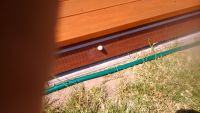Hi!
I am looking for hints on how I can solve my problem.
Well, I made the wooden terrace myself and thought that I would install the led strip in the front board (the terrace is low, it has only one degree). As I thought I did. Then I figured out that I would like the power of the remote control to choose different lighting modes. I bought the right items and currently there are 3 modes: enable, disable and enable for motion detectors.
I have some problems with this 3 mode.
I bought 7 Orno detectors -> OR-CR-211 (unfortunately I can't place the link: /)
They are connected in parallel and placed so that they cover the area of interest to me.
The problem is that they are damn sensitive (even in reduced sensitivity they catch me from about 6-7 meters). I have set the maximum excitation time (8 min) and the effect is that they shine almost all the time. To my eye, there is no error in the installation, so do not focus on it, because I have already tested it. It's more about their location. They are very close to the ground and probably even a worm running in the grass, due to its close proximity to the sensor, is able to arouse them. Another thing is that the area is not yet fenced and there are roaming neighbors' cats, etc.
My current idea for now is to paint (cover) the bottom half of the sensor so as to at least exclude any bugs and mice running in the grass. You can also try to paint over the "sections" on the sensor, but it is so small that I do not know if it makes sense.
Could you give me a reasonable idea how to deal with this situation? I warn you that hunting for cats and mice is out of the question
I paste an illustrative photo for a better understanding of matter:

Thank you in advance for any help!
pzdr
Marcin
I am looking for hints on how I can solve my problem.
Well, I made the wooden terrace myself and thought that I would install the led strip in the front board (the terrace is low, it has only one degree). As I thought I did. Then I figured out that I would like the power of the remote control to choose different lighting modes. I bought the right items and currently there are 3 modes: enable, disable and enable for motion detectors.
I have some problems with this 3 mode.
I bought 7 Orno detectors -> OR-CR-211 (unfortunately I can't place the link: /)
They are connected in parallel and placed so that they cover the area of interest to me.
The problem is that they are damn sensitive (even in reduced sensitivity they catch me from about 6-7 meters). I have set the maximum excitation time (8 min) and the effect is that they shine almost all the time. To my eye, there is no error in the installation, so do not focus on it, because I have already tested it. It's more about their location. They are very close to the ground and probably even a worm running in the grass, due to its close proximity to the sensor, is able to arouse them. Another thing is that the area is not yet fenced and there are roaming neighbors' cats, etc.
My current idea for now is to paint (cover) the bottom half of the sensor so as to at least exclude any bugs and mice running in the grass. You can also try to paint over the "sections" on the sensor, but it is so small that I do not know if it makes sense.
Could you give me a reasonable idea how to deal with this situation? I warn you that hunting for cats and mice is out of the question
I paste an illustrative photo for a better understanding of matter:

Thank you in advance for any help!
pzdr
Marcin



